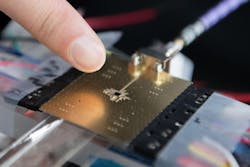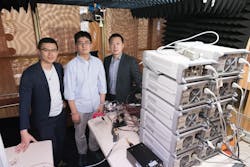A new type of device—a hybrid antenna with electronics developed by electrical engineers at the Georgia Institute of Technology—puts several transmitters and receivers on the same IC chip or package, potentially enabling multiple-input-multiple-output (MIMO) systems as well as boosting data rates and link diversity. They hybrid chip uses conventional materials and integrated circuit technology, so no changes or advances are needed to fabricate them.
“In this proof-of-example, our electronics and antenna were designed so that they work together for a unique on-antenna outphasing active load modulation capability that significantly enhances the efficiency of the entire transmitter,” says Hua Wang, an assistant professor in Georgia Tech’s School of Electrical and Computer Engineering. “This chip could replace many types of transmitters in wireless mobile devices, base stations, and infrastructure links in data centers.”
A packaged millimeter-wave transmitter with antenna-electronics co-designed by Georgia Tech researchers. The ultra-miniaturized IC chip contains an on-chip antenna and all the required electronics for millimeter wave signal generation and transmitting. Multiple IC chips can be tiled together to form a large array for 5G MIMO applications. (Credit: Allison Carter, Georgia Tech)
The new device maintains high energy efficiency regardless of whether it operates at its peak or average output power. The efficiency of most conventional transmitters is high only at the peak power and drops substantially at low power levels, resulting in low efficiencies when amplifying complex spectrally efficient modulations. Moreover, conventional transmitters often add the outputs from multiple electronics using lossy power combiner circuits, increasing the loss of efficiency.
“We combined the output power though a dual-feed loop antenna, and our innovation in the antenna and electronics lets us substantially improve the energy efficiency,” says Wang, the Demetrius T. Paris Professor in the School of Electrical and Computer Engineering. “The innovation in this design is merging the antenna and electronics to achieve the so-called outphasing operation that dynamically modulates and optimizes the power transistors’ output voltages and power currents, so the millimeter-wave transmitter maintains a high energy efficiency both at peak and average power.”
Beyond energy efficiency, the design also facilitates spectrum efficiency by allowing more complex modulation protocols. That will open the door to transmitting a higher data rate within the fixed spectrum allocation that poses such a challenge for 5G systems.
Georgia Tech researchers pose with electronics equipment and antenna setup used to measure far-field radiated output signal from millimeter-wave transmitters.
“Within the same channel bandwidth, the new transmitter can transmit at a six to 10 times greater data rate,” Wang says.
The innovation is said to spring from bringing together two disciplines that have traditionally worked separately. “We merged the technologies of electronics and antennas, bringing them together to break through limits,” he explains.
The new design has been implemented in 45-nanometer CMOS SOI IC devices and flip-chip packaged on high-frequency laminate boards, where Wang says testing has confirmed a minimum two-fold increase in energy efficiency.
The antenna electronics was the result of exploring the unique nature of multi-feed antennas. “An antenna structure with multiple feeds lets us use multiple electronics to drive the antenna concurrently,” Wang explains. “Different from conventional single-feed antennas, multi-feed antennas can serve not only as radiating elements, but they can also as signal processing units that interface among several electronic circuits.
“This opens a completely new design paradigm of letting different electronic circuits drive the antenna collectively with different but optimized signal conditions,” he adds, “achieving unprecedented energy efficiency, spectral efficiency, and reconfigurability.”
The cross-disciplinary design could also simplify the fabrication and operation of multiple transmitters and receivers on the same chip, harnessing hundreds or even thousands of elements to work together as a whole system. “In massive MIMO systems, we need to have a lot of transmitters and receivers, so energy efficiency will become even more important,” Wang notes.
Having large numbers of elements working together becomes more practical at millimeter-wave frequencies because, as Wang points out, the wavelength reduction means elements can be closer together for more compact devices. These factors could pave the way for new types of beamforming essential to future millimeter-wave 5G systems.
Power demands could drive adoption of the technology for battery-powered devices, but Wang says the technology could also be useful for grid-powered devices such as base stations and wireless connections to replace cables in large data centers. In those applications, expanding data rates and reducing cooling needs could make the new devices highly attractive.
“Higher energy efficiency also means less energy will be converted to heat that must be removed to satisfy thermal management,” he says. “In large data centers, even a small reduction in thermal load per device adds up. We hope to simplify the thermal requirements of these electronic devices.”



